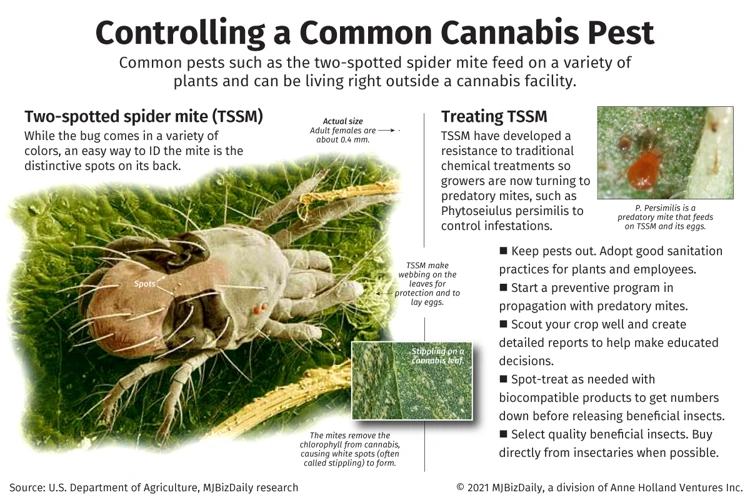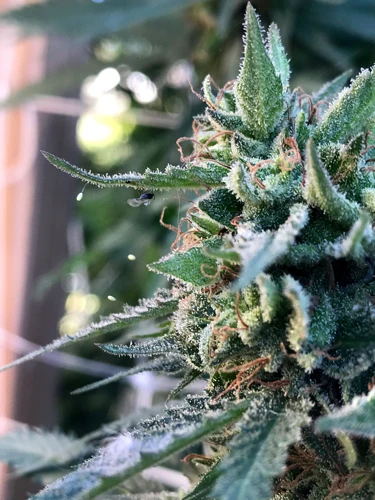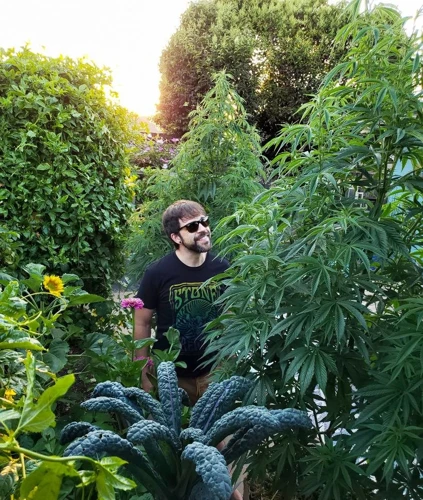
Creating a Pest-Resistant Environment for Cannabis Cultivation
The cultivation of cannabis can be a challenging task, and pests are one of the biggest obstacles to a successful yield. While some pests can be harmless, others can ruin the entire crop. As a cultivator, it’s essential to create a pest-resistant environment and take necessary measures to prevent pests from infesting your garden. From identifying common pests to implementing natural remedies and chemical pesticides, there are numerous steps you can take to ensure the health of your plants. In this article, we’ll guide you through the process of creating a successful pest-resistant environment for your cannabis cultivation.
Identifying Common Pests
Contents
As a cannabis grower, it is crucial to be able to identify common pests that can wreak havoc on your plants. These pesky critters can vary in size and appearance, but they all have one thing in common: they can cause irreversible damage to your crops if left unchecked. It’s essential to know how to spot them early on to prevent an infestation from taking over. Let’s take a closer look at some of the most common pests you might encounter in your cannabis garden.
Spider Mites
Spider mites are one of the most common pests in cannabis cultivation. These tiny pests are no bigger than the head of a pin, yet they can wreak havoc on your plants. They are difficult to see with the naked eye, which means that they can quickly multiply and infest a grow room before you even notice them.
Identification: Spider mites are tiny arachnids that are usually red or brown in color. They are known for spinning webs on leaves and around buds. If you notice these webs in your grow room, it’s a strong indication that you have spider mites.
Damage: Spider mites feed on the sap of cannabis plants, which can cause leaves to turn yellow and die. They can also stunt the growth of your plants and even kill them if left untreated.
Prevention: The best way to prevent spider mites is to maintain a clean and sanitary grow room. Make sure to regularly clean surfaces and remove any dead plant matter. Additionally, consider using a HEPA filter to prevent spider mites (and other pests) from entering your grow room in the first place.
Natural remedies: If you do have a spider mite infestation, there are several natural remedies you can try. One option is to use neem oil, which is a natural pesticide that can kill spider mites on contact. Diatomaceous earth is another natural option; this powdery substance can both kill spider mites and prevent them from reproducing. Lastly, consider introducing beneficial insects like ladybugs or predatory mites into your grow room to eat the spider mites.
Chemical pesticides: If all else fails, chemical pesticides can be used to kill spider mites. However, it’s important to choose a pesticide that is safe for use on cannabis and to follow all safety precautions when applying it. Some common pesticides used to treat spider mites include abamectin and spiromesifen.
In order to prevent spider mites from infesting your cannabis grow room, it’s important to maintain a clean and sanitary environment, use natural remedies like neem oil and beneficial insects, and only resort to chemical pesticides as a last resort. By taking these steps, you can create a pest-resistant environment that will help your plants thrive.
| Spider Mites | |
|---|---|
| Identification | Small arachnids that are red or brown in color; known for spinning webs on leaves and around buds |
| Damage | Feed on sap of plants causing leaves to turn yellow and die; can stunt growth and even kill plants |
| Prevention | Maintain clean and sanitary environment, use HEPA filter to prevent entry, and remove dead plant matter |
| Natural Remedies | Neem oil, diatomaceous earth, and beneficial insects such as ladybugs or predatory mites |
| Chemical Pesticides | Abamectin and spiromesifen are common pesticides used to treat spider mites, use with caution and follow safety precautions |
Aphids
Aphids are small, pear-shaped insects that feed on the sap of cannabis plants. They can be identified by their soft bodies and long, thin antennae. These pests can quickly multiply in number and cause significant damage to cannabis crops if left untreated.
Here are some of the characteristics of aphids that make them a threat to cannabis cultivation:
| Characteristics | Impact on cannabis plants |
| Feed on plant sap | Can cause wilting, stunted growth, and yellowing leaves |
| Produce a sticky substance known as honeydew | Can attract other pests and cause fungal growth on leaves |
| Can transmit plant viruses | Can weaken the plant’s immune system and reduce yield |
To prevent an aphid infestation, it is important to incorporate preventative measures and natural remedies into your cannabis cultivation practices. Some preventative measures include maintaining cleanliness and sanitation in your grow area, quarantining new plants before adding them to your cannabis garden, and implementing companion planting with plants that naturally repel aphids.
If an aphid infestation does occur, natural remedies such as neem oil, diatomaceous earth, and beneficial insects like ladybugs can be used to control the problem. However, it is important to note that chemical pesticides may also be used but should be used with caution as they can be harmful to human health and the environment.
Thrips
Thrips are another type of common pests that can infest cannabis plants, and they are tiny insects that feed on the sap of the plants. They can cause significant damage to the foliage and flowers, stunting the growth and reducing the overall yield of the crop.
One way to identify if thrips are present in your cannabis cultivation environment is by inspecting the plants for silver or bronze-colored scars on the leaves. Adult thrips are very small and difficult to spot with the naked eye, but you may see tiny black or brown specks on the leaves or flowers, which are their feces.
To prevent thrips from infesting your cannabis crop, it is crucial to maintain a clean and sanitary growing environment. Thrips can hide in soil, so make sure to sterilize any pots, trays, or tools before using them. Additionally, avoid overcrowding the plants as this can create a favorable breeding ground for thrips.
Companion planting can also be a useful preventative technique against thrips. For example, planting marigolds, chrysanthemums, or other species of plants that thrips avoid near your cannabis plants can act as a natural deterrent.
If thrips are present and natural remedies are not working, chemical pesticides may be necessary. Before using any chemical pesticides, make sure to read the label carefully and follow all safety precautions. Some common chemical pesticides used to control thrips include spinosad, imidacloprid, and thiamethoxam.
Here’s a table summarizing the information on thrips:
| Common Characteristics | Identification | Prevention | Treatment |
|---|---|---|---|
| Small insects that feed on the sap of the plants | Inspect plants for silver or bronze-colored scars on the leaves; look for black or brown feces on the leaves | Maintain a clean and sanitary environment; avoid overcrowding plants; use companion planting | Use chemical pesticides |
Remember to regularly monitor your cannabis plants for any signs of thrip infestation to control the problem before it becomes more severe.
Preventative Measures
It’s crucial to take proactive measures to prevent pests from harming the cannabis plants. Creating a pest-resistant environment can save growers time, money, and a headache. From maintaining cleanliness and sanitation to practicing quarantine and companion planting, there are various preventative measures that can be taken. Let’s dive deeper into some effective ways to create a pest-resistant environment for cannabis cultivation.
Cleanliness and Sanitation
Maintaining cleanliness and sanitation in the cannabis cultivation area is one of the most effective ways to prevent pests from taking over the plants.
Here are some cleanliness and sanitation practices to follow:
| Practice | Description |
|---|---|
| Regular cleaning | Clean the cultivation area regularly, including equipment, tools, floors, and walls. Pests can hide in dust and debris, so ensure that there is no buildup in the area. |
| Proper waste disposal | Dispose of any organic matter, such as dead leaves and plant debris, outside the cultivation area or in sealed containers. Pests can thrive on decaying plant matter, so it’s crucial to keep the area clean and free from debris. |
| Regular inspections | Inspect the plants regularly for signs of pest infestation. This can help you catch pest problems early on and prevent them from spreading. Focus on the undersides of leaves and check for webbing, discoloration, and holes. |
| Hygiene practices | Follow good hygiene practices when working in the cultivation area. Clean your hands and tools before and after handling the plants to prevent the spread of pests. |
| Isolation of infected plants | If you spot any plants that are infected with pests, immediately remove them from the cultivation area and dispose of them properly. Isolate the healthy plants to prevent the spread of pests. |
By implementing these cleanliness and sanitation practices, you can significantly reduce the risk of pest infestation in your cannabis cultivation area. However, these practices alone may not be enough to prevent pests altogether, so it’s essential to follow a multifaceted approach, including natural and chemical remedies, to protect your plants fully.
Quarantine
Quarantine is an essential step in preventing pests from entering your cannabis grow space. Quarantine the plants for at least a week before introducing them to your grow room, to ensure that they are free of pests. Inspect the plants thoroughly for signs of pests before bringing them into the grow area.
Separate recently acquired plants from the rest of the plants in your grow space, as they are more likely to have pests that can spread to the other plants. Place these plants in a separate grow area that is isolated from the rest of your plants.
Keep your grow room clean and disinfected to prevent the spread of pests. Only use tools and equipment that are sterilized between each use. Keep your floors and walls clean, and dispose of any plant debris immediately.
Avoid bringing in items from the outside that may have pests on them, such as clothing, shoes and tools. If you must use an item that has been outside, such as a gardening tool, sterilize it before bringing it into your grow area.
Monitor quarantined plants on a regular basis for signs of pests. If you notice any signs of pests, such as yellow spots or webbing, remove the plant from your grow area immediately and treat it with natural or chemical pest control measures.
By following these quarantine measures, you can prevent pests from entering your grow space and keep your cannabis plants healthy and pest-free.
Companion Planting
Companion planting is an age-old technique that involves the cultivation of a combination of plants that benefit each other in different ways. By interplanting companion plants with cannabis, you can create a pest-resistant environment.
Here are some examples of companion plants for cannabis and their benefits:
| Companion Plant | Benefits |
|---|---|
| Marigolds | Repels aphids, thrips, and whiteflies |
| Mint | Repels spider mites, aphids, and cabbage moths |
| Basil | Repels thrips, flies, and mosquitoes |
| Lavender | Repels fleas, moths, and mosquitoes |
| Nasturtiums | Repels whiteflies, squash bugs, and cucumber beetles |
As you can see, interplanting your cannabis with these companion plants can help deter a variety of common pests. Additionally, many of these companion plants have natural insecticidal properties, which can help protect your cannabis from infestations.
When selecting companion plants to interplant with cannabis, it’s important to consider the specific pests that you’re trying to deter. You’ll also want to avoid plants that attract pests or harbor diseases, as these can have the opposite effect of what you’re trying to achieve.
While companion planting can be a great natural way to create a pest-resistant environment for your cannabis, it’s important to note that it’s not a foolproof solution. You’ll still want to take other preventative measures and consider natural remedies or chemical pesticides if necessary.
Natural Remedies
When it comes to pest control in cannabis cultivation, opting for natural remedies can be a great alternative to chemical pesticides. Natural remedies are not only safer for the environment, but also for the health of the cannabis plants and those consuming the final product. Fortunately, there are several effective natural remedies available that can help you keep pests at bay while maintaining a healthy crop. In this section, we will discuss some of the most popular and effective natural remedies for pest control in cannabis cultivation.
Neem Oil
Neem oil is a popular natural remedy for pests in cannabis cultivation. It is derived from the seeds of the neem tree and contains compounds that repel and disrupt the life cycle of a wide range of insects. Here’s a detailed overview of the benefits of using neem oil as a pest-control measure:
| Benefits of Neem Oil |
| 1. Effective against a wide range of pests: Neem oil works against several common cannabis pests, including spider mites, aphids, thrips, and whiteflies. |
| 2. Safe for plants: Unlike chemical pesticides that can damage plants, neem oil is safe to use on cannabis plants at any stage of growth. |
| 3. Prevents fungal growth: Neem oil has antifungal properties, which makes it an effective preventative measure against fungal growth on cannabis plants. |
| 4. Easily available: Neem oil is easily available in many gardening stores and online marketplaces. |
To use neem oil, mix it with water and a few drops of soap to emulsify it. Then, use a spray bottle to apply the solution to the affected areas of your cannabis plants. It is recommended to use neem oil during the vegetative stage of growth, as it can leave a bitter taste on buds if used during the flowering stage.
It is important to note that while neem oil is a natural remedy, it can still be harmful if not used properly. Avoid applying it in direct sunlight or temperatures above 90°F, as this can cause the leaves to burn. It is also recommended to test a small area of your plants for any adverse reactions before applying it on a larger scale.
Neem oil is a highly effective and safe natural remedy for pest control in cannabis cultivation. Incorporating it into your pest management routine can help keep your plants healthy and pest-free.
Diatomaceous Earth
One natural remedy for keeping pests at bay in cannabis cultivation is the use of diatomaceous earth. This substance is made from the fossilized remains of diatoms, a type of aquatic algae. The powder is comprised of tiny, abrasive particles that damage the exoskeletons of insects and other pests, causing dehydration and ultimately death. Here are some key facts to keep in mind when using diatomaceous earth:
- Application: Spread a thin layer of diatomaceous earth around the base of cannabis plants or on the soil surface. Be sure to wear a mask when applying to avoid breathing in the fine powder.
- Effectiveness: Diatomaceous earth is effective against a variety of pests, including fungus gnats, spider mites, and thrips. However, it may not provide long-term control and may need to be reapplied periodically.
- Limitations: Diatomaceous earth is not selective and can harm beneficial insects as well as pests. It is also ineffective against pests that do not have exoskeletons, such as slugs and snails.
- Safety: Diatomaceous earth is generally considered safe for humans and animals, but it can be irritating to the eyes and lungs if inhaled. Wear protective clothing and a mask when handling.
- Storage: Keep diatomaceous earth in a dry location to prevent it from clumping. It can be stored indefinitely if kept dry.
Diatomaceous earth is a useful tool in the fight against pests in cannabis cultivation. When used properly, it can provide effective control without the use of harsh chemicals.
Beneficial Insects
One of the most effective ways to control pests in a cannabis cultivation environment is through the use of beneficial insects. These insects are natural predators of common pests and can help keep their populations under control. Here are some beneficial insects to consider:
- Ladybugs: Ladybugs are great for controlling aphids, spider mites, and thrips. They are available for purchase online or at gardening stores and can be released directly into the cultivation environment.
- Green Lacewings: Green lacewings are also effective against aphids, as well as whiteflies and spider mites. They can be purchased as eggs or larvae and released directly into the environment.
- Praying Mantis: Praying mantis are effective against a wide range of pests including aphids, mites, beetles, and even caterpillars. They can be purchased as egg cases and released into the environment.
- Nematodes: Nematodes are microscopic worms that are effective against a wide range of soil-dwelling pests. They can be added to the soil and will feed on pest larvae.
When using beneficial insects, it’s important to remember that they need a stable environment in order to thrive. Avoid using chemical pesticides or other harmful substances that could harm the beneficial insects. Additionally, make sure to properly research each insect’s habitat, ideal temperature range, and feeding habits to ensure that they are a good fit for your particular cultivation environment.
Chemical Pesticides
When it comes to cannabis cultivation, pests can wreak havoc on your plants and ultimately your harvest. While preventative measures and natural remedies are often the preferred methods for pest control, there may come a time when chemical pesticides are necessary. However, it’s important to exercise caution and carefully consider the type of pesticide you use, as well as safety precautions to protect your plants, yourself, and the environment. In this section, we’ll explore the use of chemical pesticides in cannabis cultivation and what you need to know.
Types of Chemical Pesticides
Chemical pesticides are a common way to get rid of harmful pests in cannabis cultivation. They are effective, but they also have their downsides. Before using any chemical pesticide, it’s crucial to understand the types available. Here are some common types of chemical pesticides used in cannabis cultivation:
- Insecticides: These pesticides are designed to kill insects. They come in different varieties, such as contact insecticides, systemic insecticides, and stomach poisons. Common insecticides used in cannabis cultivation include pyrethroids, neonicotinoids, and organophosphates.
- Fungicides: These pesticides are designed to kill fungi that cause diseases in plants. Common fungicides used in cannabis cultivation include chlorothalonil, copper sulfate, and myclobutanil.
- Herbicides: These pesticides are designed to kill weeds. They come in selective and non-selective varieties. Common herbicides used in cannabis cultivation include glyphosate, 2,4-dichlorophenoxyacetic acid (2,4-D), and paraquat.
- Rodenticides: These pesticides are designed to kill rats and mice. Common rodenticides used in cannabis cultivation include warfarin, bromadiolone, and chlorophacinone.
It’s important to note that the use of chemical pesticides should always be a last resort. They can have negative effects on the environment and pose health risks to humans and pets. It’s always best to try natural remedies and preventative measures first before turning to chemical pesticides. If you do decide to use chemical pesticides, make sure to follow safety precautions and use them sparingly.
Safety Precautions
When using chemical pesticides to create a pest-resistant environment for cannabis cultivation, safety precautions must be taken to ensure the health and safety of oneself and others, as well as the integrity of the crop.
Here are some important safety precautions to keep in mind:
– Wear protective clothing and equipment, such as gloves, a mask, and goggles, to protect yourself from inhalation and skin exposure.
– Avoid overuse or misuse of pesticides, as this can lead to resistance, environmental harm, and potential harm to beneficial insects and other wildlife.
– Always read and follow the label instructions carefully, as this can help ensure proper dosage, application, and safety.
– Store pesticides in a secure, locked location, out of reach of children and pets.
– Dispose of pesticides properly, according to local regulations and guidelines.
– Keep records of pesticide use, including the active ingredient, dosage, application method, and date, as this can help track effectiveness and minimize the risk of accidental exposure.
By following these safety precautions, cannabis growers can help create a safe and sustainable pest-resistant environment for their crops, while minimizing the potential for harm to themselves and others.
Conclusion
In conclusion, creating a pest-resistant environment for your cannabis cultivation is crucial in producing high-quality yields. With proper identification of common pests, implementing preventative measures, utilizing natural remedies, and, if necessary, chemical pesticides, you can significantly reduce the risk of infestation and the negative impact it can have on your crops.
Remember to prioritize cleanliness and sanitation, implement quarantine procedures for new plants, and consider companion planting to deter pests naturally. Utilize the power of natural remedies, such as neem oil, diatomaceous earth, and beneficial insects, in your pest control strategy.
However, when using chemical pesticides, it is important to carefully consider the type of pesticide being used and take necessary safety precautions to avoid harm to both the plants and yourself.
In summary, creating a pest-resistant environment is a combination of proactive measures and utilizing various resources to keep pests at bay. By implementing these strategies, you can ensure a healthy and thriving cannabis crop.
Frequently Asked Questions
What are spider mites?
Spider mites are tiny pests that can feed on cannabis plants, causing damage to leaves and reducing yields.
How do I identify aphids?
Aphids are small insects with soft bodies, and are usually green or black in color. They often cluster on the undersides of leaves and can cause wilting or yellowing of affected leaves.
What are thrips?
Thrips are small, slender insects that can cause damage to cannabis plants by feeding on leaves and flowers, and can also transmit viruses to the plant.
Why is cleanliness important in pest prevention?
Cleanliness helps to eliminate potential habitats for pests, and reduces the likelihood of infestations.
What is quarantine in terms of preventing pests?
Quarantine involves isolating new plants for a period of time before introducing them into an existing grow area, to ensure that they are free of pests or disease.
How does companion planting help prevent pests?
Companion planting can help repel pests by introducing strong smelling or pest-resistant plants near cannabis plants.
What is neem oil and how does it work as a natural remedy?
Neem oil is a natural pesticide that can be used to control a variety of pests. It works by disrupting the insect’s feeding and reproductive systems, ultimately leading to their demise.
What is diatomaceous earth and how does it work as a natural remedy?
Diatomaceous earth is a natural powder made from fossilized diatoms. It works by dehydrating and abrading the exoskeletons of insects, leading to their eventual death.
What are beneficial insects and how can they help control pests?
Beneficial insects are insects that can be introduced into a grow area to help control pest populations. Examples include ladybugs, lacewings, and predatory mites.
What safety precautions should I take when using chemical pesticides?
When using chemical pesticides, it is important to wear protective gear such as gloves and a mask, to avoid skin contact and inhalation of fumes. Pesticides should also be used according to instructions and stored out of reach of children and pets.





